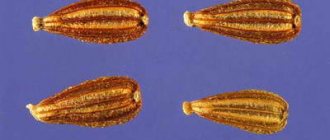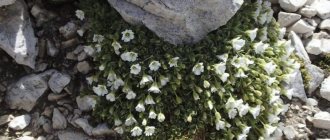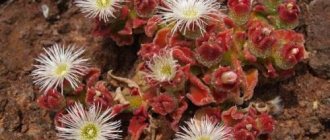The unpretentious plant Sidalcea has bright buds located on high inflorescences. It can be used in the design of borders and flower beds, and looks good on the shore of a reservoir. The flower is often planted in mixed borders; in the background it beautifully shades shorter plants. Planting and caring for sidalcea is not difficult even for beginners in gardening.
Description of Sidalcea
Sidalcea flower photo variety Sidalcea candida 'alba'
Sidalcea belongs to the Malvaceae family. Nature has created about 30 species, but only a few are cultivated. North America is considered the birthplace of the flower. It is a herbaceous perennial with a straight, strong stem reaching 1 meter in height. The root system is shallow, but branched and powerful. At the base of the stem a rosette of several round leaves is formed. Above, the leaves are arranged alternately along the entire length of the stem; they are carved in shape and have thinner lobes. The greenery has a bright, emerald color.
Large gramophone flowers with a diameter of about 5-8 cm cover the spike-shaped inflorescence. The bud consists of five delicate petals, reminiscent of a mallow (rose). A style with many stamens and one pistil is located in the center of the flower. The colors are bright and varied: light pink, red, scarlet, crimson, white. Blooms from early July to September.
Varietal varieties of flower
In garden plots there are various plant species, represented by Sidalcea malvoflora. One of the popular types, with large buds of a pinkish or red hue. The representative does not require complex care and is characterized by abundant flowering.
Common varieties are presented:
- Sidalcea Party Girl - bushes grow up to 120 cm in height and 40 cm in width. Peduncles occupy half the size of the stem; the flowers are red-pink in color with a white center. Cup-shaped buds up to 5 cm in diameter, with silk petals. Blooms from June to August, needs winter shelter.
- The Sidalcea variety Candy Girl is characterized by a lightened center and raspberry or pink petals. The bush is 0.5-0.7 m high, the average bud diameter is 4 cm. It belongs to the hybrid forms.
- Sidalcea Diamond - large pink buds are collected in spike-shaped inflorescences. The flowers reach 5 cm in diameter, the plant itself is 80 cm. It blooms in June and fades at the end of September. Copes successfully with frosts.
- Sidalcea variety Elsa Huge - with soft pinkish silky flowers.
The variety of colors and sizes of bushes allows you to choose the ideal interior solution for your personal plot.
Growing Sidalcea from seeds
Sidalcea seeds photo
Sowing in the ground
The seeds are collected in the fall, when the capsules become dry and fully ripe. Carefully separate them and place them in spacious bags for storage until spring. You need to sow immediately in a permanent place of growth. Wait for stable heat, when the thermometer is 10°C or more, then seedlings will quickly appear and the plant will actively develop.
- Loosen the soil well, form grooves 2-3.5 cm deep, and lightly cover the sowing with soil.
- Young shoots will appear in 15-20 days.
- Immediately check the density of the seedlings, thin out if necessary, leaving a distance between plants of about 10-15 cm.
- When four true leaves appear, repeat thinning, leaving the strongest flowers, and increase the distance between them to 40-50 cm.
The torn plants are also quite resilient; you should not destroy them; you can use these seedlings in other areas of the garden. In order for flower buds to form, the plant must overwinter; expect flowering next year.
Growing for seedlings
Sidalcea seedlings photo
Sidalcea can also be grown in seedlings: sow the seeds at the end of February, one or two at a time, in separate containers to a depth of 1 cm. Provide regular watering and good lighting. You can sow in a common container, but then pick at the stage of 3-4 true leaves.
Seedlings are planted in May, having previously been hardened off for two weeks.
Reproduction methods
Skumpia: description and varieties, planting and care
Sidalcea seeds
As they wither, Sidalcea flowers form boxes in which the seeds ripen. You can grow the crop by seed either from purchased material or using flowers collected with your own hands. Therefore, by purchasing a small amount of seed, you can sow the entire plot with it in 3-4 years.
Planted in open ground, Sidalcea seeds will produce flowering stems only next year. If there is a desire to get flowering already in the current season, then the seeds are initially sown in peat cells. They retain moisture perfectly, do not require disturbing the earthen coma during transplantation, and are breathable without causing stagnation of water. This planting of seedlings occurs in late February - early March, picking - after 1-2 months after reaching 2 leaves on the plant. And planting in open ground is possible if there are 4 or more leaves and the air temperature is from 10 degrees Celsius. An important point in this regard is two-week hardening. It is carried out by exposing it to air during the daytime and then returning it to the room at night. The stems adapt and feel better when transplanted.
An adult bush can also be propagated by division. It also produces flowering in the year of planting. But it is worth considering the fragility of the rhizome. Although it is on the surface, it can lose its viability, both from mechanical damage and from drying out. But this method is quite simple even for an amateur gardener, if desired and has patience.
Reproduction of Sidalcea by dividing the bush
An overgrown perennial plant can be propagated by dividing the bush. To do this, carefully separate the young shoots from the main plant; it is important not to damage the roots, because they are superficial and thin. You can replant in the spring before flower buds form.
After dividing, immediately place the roots in the soil, because dried roots will not take root. If you plan to transport or store for a longer period of time, you can place it in a bag or other airless packaging.
Care Tips
Sidalcea has low habitat requirements. It adapts to most garden soils provided there is good water permeability. A substrate enriched with humus or manure ensures lush flowering and good growth of the perennial.
Choose a sunny place for planting sidalcea, as in full sun the inflorescences have a brighter and more saturated color. The substrate should be moderately moist, but not wet. Regular watering is required during dry periods. To prevent the soil from drying out, the plantings are mulched with grass or humus.
Caring for Sidalcea also involves trimming the stems almost to the base of the bush after flowering. The procedure stimulates re-blooming and development of peduncles for the next year.
When planting in poor soil, mineral complex fertilizer for flowering plants is applied 3-4 times over the entire season, starting in spring. Fertilize at the root and only after watering. In areas with cold winters and in the absence of snow, plantings are mulched with dry leaves, spruce branches or peat. In the middle zone, the perennial overwinters without problems.
When creating varieties, breeders were able to preserve and enhance such perennial qualities as resistance to diseases and their pathogens and ensure high compatibility with other garden plants.
Sidalcea care
Sidalcea little princesses planting and care photo flowers
Sydalcea is quite easy to care for, you just need to take a little care of it. First prepare the soil for planting. Ordinary garden soil will suit it well, just clear it of weeds and other debris and loosen it well.
Landing place
Choose a sunny place for planting, only slight shade is acceptable. Although it will grow in the shade, don’t expect abundant foliage and flowering. It will reveal its maximum potential only in the open sun.
Watering
The plant does not tolerate drought well: water regularly and apply complex fertilizers. In order for Sidalcea to fully develop, it needs to be watered three times a week (provided there is no natural precipitation). Young plants are watered only with warm water. Mulching with humus or mowed grass will help retain moisture. Weed the plant regularly, this will help saturate the soil with air, prevent rotting and have a positive effect on growth and flowering.
Trimming
Due to the shedding of ripened seeds, wild, dense growth can form. The number of self-seedings will be reduced by pruning of wilted stems. The entire stem should be cut down to the ground, this will promote the growth of young shoots.
Preparing Sidalcea for winter
The root system of the flower is quite frost-resistant and does not require careful covering. Only in regions with cold winters (when frost is -20°C or more) is it worth covering the roots with fallen leaves or branches, protecting them from snowless frosts:
- It is good for the plant if, after trimming the above-ground part around, mulch the ground with a thick layer of leaves (up to 20 cm) and cover it with spruce branches on top.
- In the spring, after the snow melts, the mulch is removed to free the plant for growth.
Gardeners do not need to worry about protection from parasites and diseases; the plant has good resistance to them.
Application in landscape design
Osteospermum: description, planting and care
Sidalcea can be an excellent solution for landscape design. Its unpretentiousness greatly facilitates plant care, and the variety of shades allows you to combine it with a wide variety of flowers or create beautiful compositions from several plant varieties.
Sidalcea can be used for the following purposes:
- To delimit space.
- As an element of group planting for decorating walls and fences.
- In front gardens with a low fence.
- To create a background in a variety of one-sided flower beds.
- In the center of flower beds, which are visible from all sides
- As an element to disguise a compost heap or other aesthetically unattractive elements of the garden.
- For decorative design of lawns.
- When designing mixborders, ridges or flower beds.
- As a hedge.
- As a solitary plant in a remote area of the site.
- To create a spectacular tall undergrowth near sparsely planted trees.
- Less tall varieties are used to decorate the porch or veranda.
Sidalcea also looks good when cut, so it is used not only in landscape design, but also in decorating a room with the help of bouquets.
It can coexist with any other flowers that also prefer sunny places. The following combinations are especially beautiful:
- With medium-height annual plants - lupine, phlox, chamomile, echinacea and cosmos.
- In a rustic flower garden, complete with delphinium and golden balls.
- In combination with calendula, campanula, aquilegia or lavatera.
- As the background of a composition where the foreground is occupied by pansies or daisies.
- In mixboards with cuff, large cornflower, Byzantine chistets, monarda.
In addition to flowers, sidalcea looks very beautiful against a stone background. Its light or bright pink flowers with delicate petals or snow-white Brilliant look great against a gray background. This combination creates a romantic and cozy atmosphere.
Sidalcea can be an excellent choice for any flower bed or garden. It offers a huge variety of combinations, and simple care will allow you to pay more attention to its whimsical and capricious neighbors. Among the variety of varieties of this flower, you can always find the one that was missing in your flowerbed.
Types and varieties of Sidalcea with photos and names
Sidalcea malviflora
Sidalcea party girl party girl photo
Malvoflowered sidalcea is the most popular; gardeners are very fond of this beauty. Its flowers are large, pink or red. And if you remember from childhood, its petals can be divided in half and glued to the face, depicting Papuans. Children love this game very much.
Any variety of Sidalcea is easy to care for and blooms profusely.
Perennial sidalcea: decorative properties
Complex plantings allow you to zone the space with light floral nuances. And as tapeworms, perennial sidalcea looks great, both in the center of the flowerbed and in the background. It can cover unsightly buildings. The aroma of these flowers is not too noticeable, but the color itself blends beautifully with other neighboring plants. By the way, sidalcea gets along well with other types of vegetation, but with sufficient limitations for the growth of the rhizome (usually half a meter is enough).
Sidalcea in the garden
When cut, sidalcea can be either a mono-bouquet or a bright accent to flowers of a different color. And it can also be positioned on the sides, in the center or on the side. And one of the species of Sidalcea, which has a white color, is used at American weddings as a mandatory symbol of a long and happy life for the newlyweds.
Rules for outdoor care
Sidalcea is an unpretentious crop, suitable even for novice gardeners. Proper care allows you to maintain the health and decorative appearance of the bush and prolong flowering. Basic rules for working with the plant:
- Watering should be regular and plentiful - the plant prefers high humidity. During active growth, water can be applied 3-4 times a week; during hot weather, additionally spray the leaves;
- the soil should be light and aerated. To do this, loosening should be carried out systematically, the optimal frequency of the procedure is 2 times a month. At the same time, you should weed the flowerbed to remove weeds;
- Fertilizers are applied only during the growing season of the bush (from spring to the second half of summer). As a top dressing, you can use ready-made mineral compositions or organic matter, for example, an aqueous solution of mullein;
- after flowering ends, you need to cut off all the buds, and before winter, cut the bush, leaving 10-12 cm above the ground surface. This stimulates growth and prevents the development of infections;
- planned transplantation is required every 5-7 years. It is permissible to carry out the procedure more often if the plant develops slowly and forms small flowers.
Sidalcea is rarely affected by pests anymore. Treatment is carried out only when signs of infection are detected. If the rules of care are not followed, there is a risk of the stem drying out and the flowers wilting. To avoid this problem, it is important to monitor the humidity of the substrate and water regularly.
Wintering
The plant can withstand even severe frosts. The bush can tolerate cold down to -25 oC. Before the start of winter, the sidalcea needs to be completely pruned. Mulch the soil with sawdust or wood chips in a layer up to 15 cm thick. In the northern regions, the planting can be additionally covered with spruce branches or agrofibre. The covering layer is removed with the beginning of massive snow melting.
Varieties
Most garden varietal forms were obtained as a result of selection from the original species of S. malvaeflora.
— “Little Princess”, height up to 1 m, light pink inflorescences;
— Sidalcea “Diamond” has a rich pink color;
- "Party Girl". This variety has a color palette ranging from pink to purple-red. The stems are erect, perfect for cutting;
— “Croffway Red” 90-95 cm high, dark red inflorescences;
— “WILLIAM SMITH” with dark pink dense inflorescences;
— “Elsie Hugh” with delicate pink flowers.
No less popular is the species Sidalcea candida with large snow-white, showy inflorescences.
Varieties
Most garden varietal forms were obtained as a result of selection from the original species of S. malvaeflora.
— “Little Princess”, height up to 1 m, light pink inflorescences;
— Sidalcea “Diamond” has a rich pink color;
- "Party Girl". This variety has a color palette ranging from pink to purple-red. The stems are erect, perfect for cutting;
— “Croffway Red” 90-95 cm high, dark red inflorescences;
— “WILLIAM SMITH” with dark pink dense inflorescences;
— “Elsie Hugh” with delicate pink flowers.
No less popular is the species Sidalcea candida with large snow-white, showy inflorescences.
Reproduction methods
As they wither, Sidalcea flowers form boxes in which the seeds ripen. You can grow the crop by seed either from purchased material or using flowers collected with your own hands. Therefore, by purchasing a small amount of seed, you can sow the entire plot with it in 3-4 years.
Planted in open ground, Sidalcea seeds will produce flowering stems only next year. If there is a desire to get flowering already in the current season, then the seeds are initially sown in peat cells. They retain moisture perfectly, do not require disturbing the earthen coma during transplantation, and are breathable without causing stagnation of water. This planting of seedlings occurs in late February - early March, picking - after 1-2 months after reaching 2 leaves on the plant. And planting in open ground is possible if there are 4 or more leaves and the air temperature is from 10 degrees Celsius. An important point in this regard is two-week hardening. It is carried out by exposing it to air during the daytime and then returning it to the room at night. The stems adapt and feel better when transplanted.
An adult bush can also be propagated by division. It also produces flowering in the year of planting. But it is worth considering the fragility of the rhizome. Although it is on the surface, it can lose its viability, both from mechanical damage and from drying out. But this method is quite simple even for an amateur gardener, if desired and has patience.











